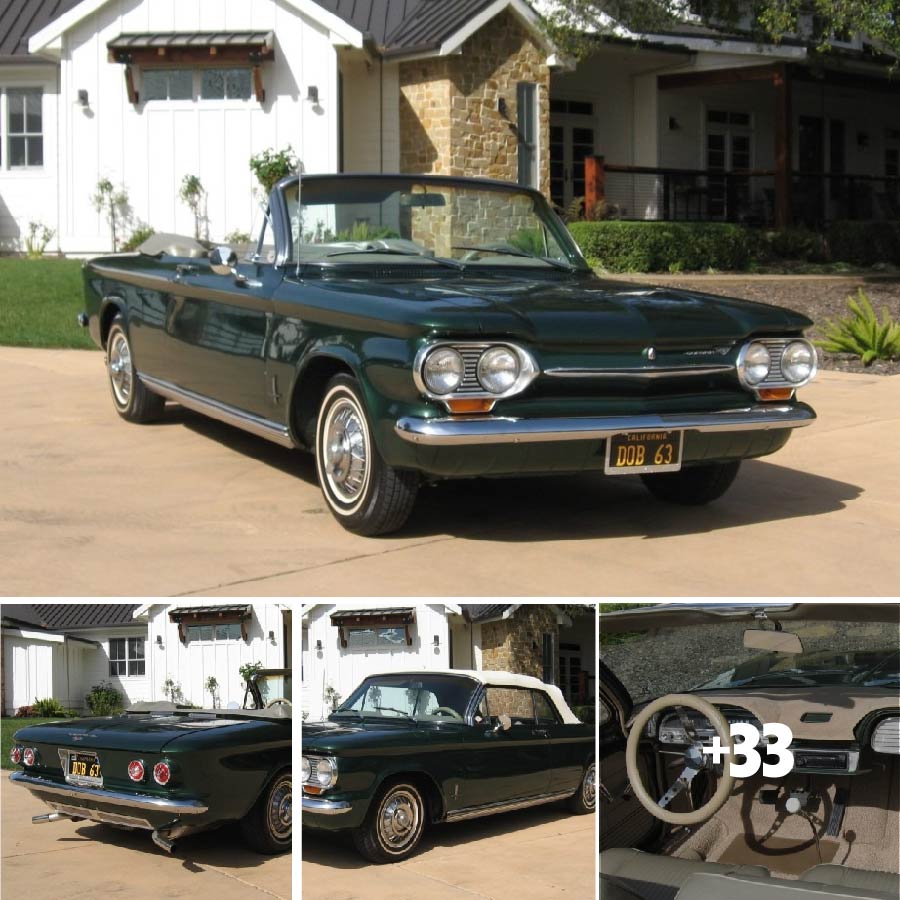
In 2019, the spouse of the current custodian procured this 1963 Chevrolet Corvair Monza, which underwent an extensive rejuvenation and enhancement. The refurbishment encompassed a repaint in a verdant hue, an overhaul of the braking apparatus, a reupholstery of the interior in tan, a replacement of the collapsible roof and the vehicle’s floor structure, as well as the installation of sound-dampening layers, fresh bumpers, door mechanisms, locking systems, and components vital to the fuel and ignition systems. Moreover, a contemporary independent rear suspension system and a 164 cubic inch horizontally-opposed six-cylinder engine coupled with a four-speed manual transaxle were fitted. Additional fittings include a tan convertible roof, a protective cover for the same, a deep-sump oil pan with cooling fins, a bifurcated exhaust setup, a Sony audio system, and 13-inch steel rims adorned with wire-spoke caps. Currently, this Corvair is available through the intermediary of the seller, complete with a vehicle cover, a dossier of maintenance records, supplementary parts, and an unblemished title from California.

Originally leaving the assembly line in Autumn Gold (920), this Corvair marked a pioneering venture by Fisher Body into unibody construction. It now sports a green exterior finish complemented by a tan roof newly installed, alongside gleaming chrome bumpers, a canopy cover for the convertible, quad beam headlamps, dual lateral mirrors, and polished tailpipe embellishers.

The vehicle is equipped with 13-inch steel wheels that feature ornate wire-spoke covers and are fitted with 175/80 Milestar Touring tires bearing a white stripe. Stored in the frontal compartment is a full-size spare tire. The Corvair’s original suspension design incorporated coil springs throughout and pivoting axles at the aft. The car’s stopping capability is assured by drum brakes at each wheel, with the brake components, linkages, and tie rods refreshed during the current ownership.

Inside, the front bucket seats and rear bench have been clad in tan vinyl, with the floor structure, carpeting, and door surfaces also replaced during the restoration. Sound insulation has been applied beneath these surfaces. Interior amenities comprise a heating unit, waist restraint systems, polished entry sills, and a Sony sound system.

A leather-bound aftermarket steering wheel offers a view of a horizontal speedometer calibrated up to 100 mph and a gauge for fuel reserves. The odometer, featuring a five-digit display, indicates 90,000 miles, of which approximately 3,000 have been added by the present owner.

Beneath the rear deck, a 164 cubic inch flat-six engine, reportedly refurbished prior to its installation in the current tenure, propels this classic. Recent mechanical attentions include the introduction of a high-energy ignition distributor, bespoke throttle linkage, a deep-sump oil pan, an auxiliary alternator, an electric fuel pump, and finned valve covers, with the fuel reservoir, conduits, and ignition cables also being replaced. An imprint of the engine’s identification number can be viewed in the accompanying image gallery.

Motive force is conveyed to the aft wheels via a substituted four-speed manual transaxle, with a recent replacement of the clutch and flywheel. The reverse gear switch was also substituted in anticipation of the sale. Notably, signs of corrosion are evident on components beneath the vehicle.
Decoding the Fisher body tag reveals:
- 04D – Fourth week of April, 1963
- 63-0967 – Corvair 900 Convertible
- Body WR 27830: – Willow Run, Michigan Assembly, production sequence
- 1-758 – Fawn vinyl interior trim, white convertible soft top
- 920 – Autumn Gold paint
